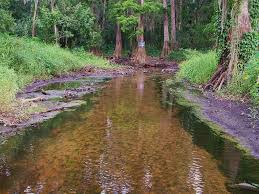Non-perennial, temporary, intermittent, or ephemeral? Let’s talk about rivers that go dry

Nonperennial rivers are a major—and growing—part of the global river network. New research and science-based policies are needed to ensure the sustainability of these important waterways.
As we make our way into the age of big data, there are an increasing number of scientific papers examining various landscape and hydrological features at a global scale. In line with this trend, recent papers have looked at river width, length, and flow on a global scale. Looking at these papers, it would seem that Australia does not have many rivers.
Yet it does. Australia has over one million rivers. But over 70% of them are dryland rivers, and flow for only part of the year. And therefore they typically aren’t recognised as rivers in these large scale analyses.
Dryland rivers, which typically cease to flow for some part of the year, go by many names. In fact, the lack of common terminology among scientists for these rivers is somewhat of a problem. This lack of terminology is confusing for both scientists and non-scientists alike, and can also have legal implications.
These rivers have also received much less scientific attention than perennial rivers, partly because they are hard to study. This is true from a logistical standpoint; they are often found in less inhabited locations, have flashy flows that wash away equipment and access roads, and have patchy rainfall leading to unpredictable flows. It is also true from a scientific standpoint; the wetting and drying cycle means many of the measurement techniques commonly used in the field are not applicable, and numerical modelling is considerably more computationally intensive.
Much of the work that has been done in non-perennial rivers has been focussed on the ecology. Less is known about the hydrology (including streamflow generation and cessation mechanisms), water balance (the relative roles of evaporation and infiltration), and the climatic and geographic drivers. That is, many studies have been done at the point or reach scale to understand specific aspects of certain rivers, but there is little overarching work to link those case studies together into a broader systems understanding.
We also don’t clearly understand how the flora, fauna, and hydrology fit together, and how humans impact these systems for the better and worse. For this, we need scientists and water managers to come together and discuss their knowledge within an interdisciplinary context. In the past 5 years, this has begun occurring in Europe and in the U.S., where networks of researchers from different fields but all studying non-perennial rivers have begun meeting to discuss commonalities and knowledge gaps. However, despite the much higher prevalence of these dryland systems in Australia, there is still no network in Australia devoted to understanding our wealth of dryland river systems- which extends far beyond the Murray Darling Basin.
It is clear that flow regimes have changed in many of our rivers, and the consequences have been severe, as highlighted by a plethora of news articles on the drying of the Darling River in Spring 2019. Now is the time for us to work together, across disciplines, to begin addressing short-term and long-term data needs, knowledge gaps, and research directions to address Australia’s pressing need for better protecting its unique waterways.
This article is adapted from the story: Shanafield, M., et al. (2020), Science gets up to speed on dry rivers, Eos, 101, https://doi.org/10.1029/2020EO139902. Published on 13 February 2020.
